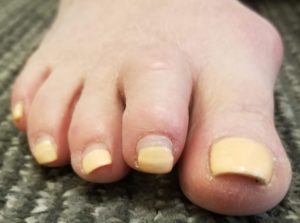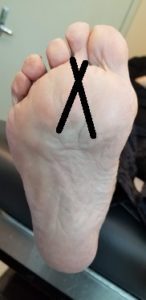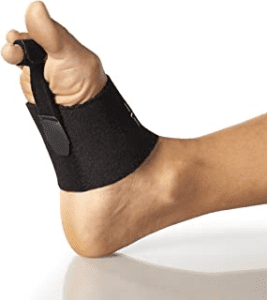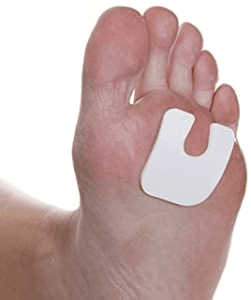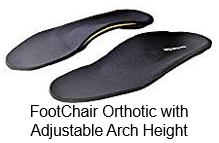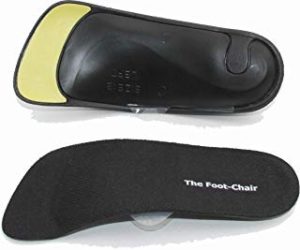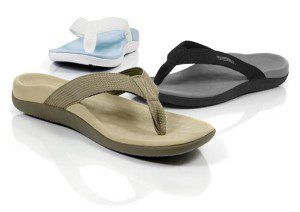Plantar Plate Tears Can Cause Floating Toes and Chronic Ball of Foot Pain
Pain from a plantar plate injury is one of many causes of pain under the ball of the foot most commonly under your second toe. This is one of the most common causes of chronic pain under the ball of the foot that does not respond to standard conservative ball of foot pain treatment.
The pain can range from mild to severe, and it’s important to treat a plantar plate tear as soon as you start feeling the pain in order to prevent it from getting any worse. Be sure to make an appointment to see one of our skilled podiatrists at the Foot and Ankle Center of Washington as soon as possible.
If you are out of town, or located too far away from our office in Seattle to make an appointment, you can try some of the conservative treatments for plantar plate injuries, but always be sure to see a podiatrist if the pain does not improve or gets worse.
What is the Plantar Plate?
There’s a good chance you’ve never heard of the plantar plate before, and that is because it’s really a very small structure in your foot that doesn’t receive a lot of attention.
On the bottom of the ball of your foot your metatarsal bones meet the floor, and a lot of your body weight presses down on the metatarsal bones. In order to protect the metatarsal bones at the ball of your foot, the body developed a small piece of tough thick tissue to absorb compressive forces. That tough fibrocartilaginous tissue is known as the plantar plate, and it’s held in place by a thick ligament band that prevents it from slipping.
Every foot has 4 plantar plates, one for each metatarsal head and toe joint. The plantar plate normally provides protection for the bones of your foot while you walk, run, jump and bend.
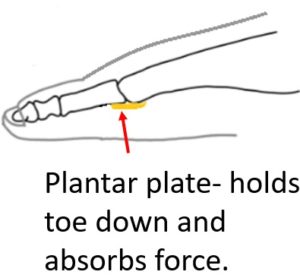
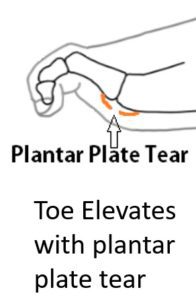
Plantar Plate Injury can occur Suddenly or Slowly
A plantar plate injury occurs when there is a plantar plate tear, or a plantar plate rupture. This is sometimes called a plantar plate sprain, however this is not exactly the correct term.
Sometimes these tears happen quickly, when you bend your toes upwards and feel a tearing, electric shock or popping sensation at the bottom of the ball of your foot.
More often a plantar plate injury has a slow onset, you may notice a mild pain or discomfort at first, which slowly gets worse over time. Plantar plate injury is often misdiagnosed at first, and you may go weeks or even months with the wrong treatment. This is why it is so important to be examined by a doctor who is an expert in diagnosing and treating these plantar plate injuries conservatively and surgically.
The plantar plate contains cartilage, which means that it has a very hard time healing on it’s own. Injury can be very frustrating to manage on your own and should be treated ideally by a qualified doctor. Even with the proper care, plantar plate injuries can take months to heal properly or not completely heal.
What are Symptoms of a Plantar Plate Tear or Rupture?
Most of the time a plantar plate injury will occur under the second metatarsal head, however in rare circumstances it can happen to toes 2-5.
If your injury happens suddenly:
- Pop, electric shock or tearing feeling under the lesser toes at the ball of the foot
- Stabbing or shoot pain
- Redness and swelling around the ball of your foot and toe
- Notice sudden elevation of your toe
If the injury develops slowly:
- Soreness and aching across the ball of your foot
- Feeling as if there is a “balled up sock” under your toes
- Feeling as it there is a pebble, or a pea stuck in your shoe under the toes or ball of your foot.
- Pain walking in high heels
- Pain walking in flexible or flimsy shoe gear
- Slow elevation of your toe
Why do I have a Plantar Plate Tear?
There are two general ways you can develop a plantar plate injury, directly and indirectly. Certain factors that are beyond your control may have contributed to your injury.
Your plantar plate injury may be caused directly by trauma, like playing sports, slipping, falling or even a vehicle accident. If the injury is caused by a direct known trauma it is likely going to hurt more than an indirect injury and it may even feel like a broken bone.
We often find that there is no known direct cause for a plantar plate injury, and you may notice the ball of your foot just slowly begins to hurt and feel worse over time.
Some contributing factors to these indirect injuries include:
- Shoe gear
- High impact activities like running or playing sports
- Biomechanics of the feet and legs
- Weight
- Genetics
When an indirect plantar plate injury occurs it is critical to consult a podiatrist specializing in these fields to determine the cause of your injury. At the Foot and Ankle Center of Washington Dr.Hale and Dr.Huppin specialize in optimizing your unique biomechanics using orthotics to avoid injuries like plantar plate tears and reduce force off your tear.
Plantar plate injury occurs frequently in people who have hammertoe deformities, this is likely due to the increased pressure on the metatarsal head when the toes form a claw like shape. Certain foot types, such as feet with high arches can place additional pressure on the plantar plate, and make you more prone to injury.
Plantar Plate Tears are More Common in Women
Plantar plate injuries are also more common in women. Although it’s not clear exactly why, it’s commonly believed this is due to the shape and angle of women’s shoes causing increased pressure on the metatarsal head and plantar plate.
Plantar Plate Tear Treatment:
Treatment for plantar plate injuries is easiest in the early stages of the injury, and rarely requires surgery. At the Foot and Ankle Center of Washington we strongly believe that plantar plate tears can be managed with conservative treatment options and surgery for a plantar plate tear should always be the last resort.
The first step in your treatment will always be a thorough physical examination of your feet to determine location and severity of your plantar plate injury. This may involve pinpointing the location that hurts the most, and the movements which aggravate the pain.
It is critical to rule out any alternative diagnoses before we begin treating, so a variety of tests may be necessary at this initial appointment. The exam will also include a biomechanical evaluation focused on the shape and movement of your feet while seated, walking and standing.
Bring Shoes and Orthotics to Your Appointment
Be sure to bring your shoes and any orthotics you wear with you to your first appointment, especially if a certain pair of shoes hurts more than others.
Conservative Treatment of Plantar Plate Tears
Conservative treatment is first broken down into acute sudden type injuries, as opposed to the chronic gradual type injuries.
For acute injuries treatment may include:
- Plantar Plate Taping and padding the affected toe
- Non-weight bearing period of 6-8 weeks for severe cases
- Ice therapy
- Then, you start doing the treatment for the chronic tears as listed below
For chronic or severe injuries:
- Custom orthotics designed to conform to your foot and arch tightly
- Modifications to the orthotics to reduce pressure on the plantar plate and metatarsal head
- Rigid soled shoes. Preferably with a rocker sole
- Daily taping of the toe in a manner to reduce tension on the plantar plate
- Shock wave therapy
No Steroids for Plantar Plate Tears
We absolutely never recommend a steroid injection when acute plantar plate tear is suspected, because it can make the problem worse, and even cause complete rupture of the plantar plate.
Other conditions which mimic plantar plate injuries are often treated by steroid injection, making proper diagnosis of a plantar plate injury absolutely necessary before treatment.
The plantar plate is made out of a substance that is well known to be difficult to heal.
How Long Does Conservative Treatment Take?
Plantar plate tears can often be treated conservatively, but it takes time.
Expect an average time of about 6 months for healing of plantar plate tears.
During that 6 month period it is critical that you not go barefoot at all. It will usually take months of aggressive care to properly recover from an injury of this type.
During this period every moment you are bearing weight you should be wearing orthotics with proper modifications, wearing rigid soled shoes and taping your toe in a manner to reduce tension on the plantar plate.
The sooner you start treatment, the faster you can start recovery.
Plantar Plate Taping and Padding the affected toe:
Note: Some of the links below are affiliate links, which means that if you choose to make a purchase, we will earn a small commission at no additional cost to you.
A standard of care for an irritated plantar plate injury has been to use sports tape and padding to reduce tension on the plantar plate. Using the proper tape and a unique taping technique, the toe can be splinted in a position that helps it to heal.
While this taping technique can be very easily applied by a doctor, it can be cumbersome at home, so we also recommend a Plantar Plate Splint which can be easily applied at home.
Custom made padding with a cutout underneath the metatarsal head also allows for pressure relief and healing at the site of the plantar plate injury.
A generic form of these pads can be purchased online and applied either directly to your foot, or to your shoe allowing for the cut out to provide relief to the area.
In a mild plantar plate tear several weeks of taping and padding may be enough to allow the injury to heal.
Non Weight Bearing:
You may need to be either partially or completely non weight bearing for several weeks to allow the foot to recover. In mild cases, this may be the use of crutches with heel touch walking only. In more severe cases you may need 6 to 8 weeks of full non weight bearing in a protective boot with crutches or a knee scooter.
Orthotics for Plantar Plate Injuries – Custom and Prefabricated
Custom Orthotics for Plantar Plate Injuries:
At the Foot and Ankle Center of Washington we have specialized for many years in perfecting the art of custom orthotics. We believe that custom orthotics offer you the best chance at eliminating pain and preventing future injury.
Many of the contributing factors to plantar plate injury revolve around your shoe gear, the support your shoes offer, the mechanical structure of your foot, and the biomechanical function of your foot while you walk.
A type of custom made orthotic, called a total contact foot orthotic will tightly hug your foot and evenly distribute your weight over the surface of your foot when you walk or stand. This gives the arch of your foot the support it needs to relieve pressure at the metatarsal heads, and therefore reduce plantar plate injuries and speed recovery.
While cushion is important for recovery, preventing re-injury to the plantar plate requires support in the right areas of your foot. Preventing excess movement of the toe that has the plantar plate injury is very important for prevention of future injuries, and a supportive orthotic that limits motion at the forefoot can often deliver this stability.
Prefabricated Orthotics for Plantar Plate Injuries
While custom orthotics will more effectively transfer pressure off of the plantar plate, you can also try a prefabricated orthotic.
If you are going to use a prefabricated orthtoic you want to use one that conforms as close as possible to the arch of your foot. These are the ones we recommend the most:
For full size walking and athletic shoes we recommend FootChair Podiatrist Designed Adjustable Arch Orthotic
These have the best arch height we have found on an over-the-counter arch support and should do a very good job at transferring pressure off of the area of the plantar plate. The arch height can be adjusted via pads that can be inserted under the cover.
For women’s dress shoe (and other smaller shoes like soccer cleats) the recommended OTC arch support for womens’ dress shoes is the FootChair Slim Orthotic with adjustable arch support.
The FootChair Slim is the only effective OTC arch support we have found to fit in women’s heels and flats. It has the same effective adjustable arch support as the full-size FootChair but in a much less bulky profile. In addition it flexes to adapt to most heel heights.
Use a sandal or slipper with an arch support to wear around the house. This will act to decrease pressure on the ball of your foot and can help with plantar plate injuries. We usually recommend the Vionic Sandals and Slippers to our patients .
Shoe Modifications and Better Shoes
You love shoes, we understand that, but sometimes your shoes don’t love you back.
Many plantar plate injuries occur because your toes don’t have the rigid support they need from a shoe. Adding custom orthotics, or a firm insert can provide shoes with the support you need.
Some shoes do already have the rigid support you need, but lack the custom modifications you need to minimize discomfort and risk of re-injury from a plantar plate tear. This is why bringing your shoes with you to the doctors office is critical. Your podiatrist can add custom padding with a metatarsal head cut out, and support around the ball of your foot to help you recover, and stay injury free.
Some shoe trends even tout extra flexibility and a “minimalist” design. While these shoes were popular, they provide your foot with little to no support and can actually make you more prone to plantar plate injuries, among many other types of injury. The increased flexibility allows your toes to pull and tear on the plantar plate, causing injury rather than strengthening your foot.
When looking for a shoe to support your foot, try downloading our shoe guide, where we recommend supportive shoes in a variety of styles.
Shock Wave Therapy for Plantar Plate Injuries
Shock wave therapy is a non-invasive procedure performed in the office that applies micromotion to a tissue. Shockwave can help stimulate healing in tissues where healing has stalled.
While shockwave has been shown to be very effective in stimulating healing in similar tissues, it has not been studied extensively in the treatment of plantar plate injuries, making it difficult to determine exactly how beneficial it may be in treatment of this condition.
We do know that there are minimal drawbacks to shock wave therapy, and the positive results we have seen from our cases suggests it’s another tool we can use before we move to surgery.
You can learn more about shockwave therapy here.
Plantar Plate Surgery – You exhausted the conservative treatments, now what?
If you continue to feel pain after conservatively treating your plantar plate injury it may be time for additional testing.
In rare circumstances a severe plantar plate tear doesn’t respond to treatment because the plantar plate may be ruptured completely and additional structures around the area are destroyed.
Arthrogram
A imaging procedure that allows imaging of a joint after injection of dye/contrast into the joint is called an arthrogram. Arthrogram allows you to visual a hole/tear in the plantar plate. Arthrogram may done using X-ray, MRI or CT imaging. A arthrogram visualized with X-ray below. Image shows dye/contrast leaking out the bottom of the joint into the tendon shealth demonstrating a plantar plate tear.
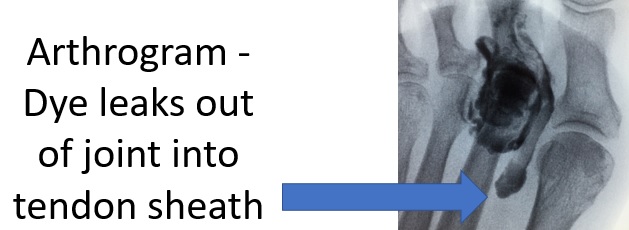
MRI for Plantar Plate Ruptures
In this case it is helpful to use an MRI (Magnetic Resonance Imaging) to view the structures in the foot. The MRI may include adding dye to the joint, in which case this is called an MRI Arthrogram. If the dye leaks out the bottom of the joint this may confirm a plantar plate tear, see image below. After having an MRI Arthrogram you will meet with your doctor again and determine if surgery is necessary, and if so, what surgery you need.

The MRI Arthrogram will be performed at a facility specialized to perform this type of procedure. Your doctor will refer you directly to the facility and ensure that you are able to get the test.
Ultrasound for Plantar Plate Injuries
Your doctor may alternatively decide to perform an ultrasound of the plantar plate, which is faster than an MRI but significantly less useful for viewing the structures and planning surgery. This is a good option if your doctor needs to determine if a MRI is necessary, or if an MRI is not an option for you due to claustrophobia or certain metal body implants.
Plantar Plate Repair Surgery
Surgery is not necessary in the majority of plantar plate injuries. Our belief at the Foot and Ankle Center of Washington is that surgery should be avoided if at all possible, and all conservative treatments should be exhausted prior to surgery. In the rare circumstance that surgery is unavoidable, various techniques for reconstructing the plantar plate rupture exist.
What happens during the surgery?
During a plantar plate tear surgery, the surgeon must sew together the tear of the plantar plate with strong thread or in some cases transfer your flexor tendon to pull the toe downwards.
The Dorsal Approach
The approach through the top of the foot is called a dorsal approach. In order to repair the plantar plate, in most cases, a bone cut must be made in the metatarsal bone, and the metatarsal head must be temporarily slid out of the way. This cut is known as an oblique osteotomy, and it heals very well, making it a practical addition to the plantar plate repair surgery. Once the head of the metatarsal is moved out of the way the surgeon will identify the plantar plate tear, or the remaining pieces of the plantar plate, and repair them.
The surgeon will place the metatarsal head back into alignment and stabilize the bone cut with a single small screw. After the surgery you will protect, ice and rest the foot for several weeks to allow for healing.
The Plantar Approach
One popular technique for approaching the plantar plate for repair is an incision made on the bottom of the foot, this is called a “Plantar Approach”. This approach is more direct and does not involve cutting the metatarsal bone. You do have to be non-weight bearing to help reduce scarring on the bottom of your foot.
Flexor Tendon Transfer:
From conservative to surgical treatment, the key to plantar plate injuries is reducing the tension on the plantar plate and prevent the metatarsal head from pushing through the plantar plate. Surgically, one very good way to do this is by changing the position of your own tendons around the affected toe to pull the toe down and release tension on the plantar plate.
We sometimes to choose a tendon transfer, using the long flexor tendon on the bottom of the foot, to the plantar plate procedure. We find this helps to reduce recurrence of the injury, and protects the plantar plate while it heals.
After a flexor tendon transfer you will notice that your toe sits more straight, and often this procedure is used to treat hammertoe deformities. You will not be able to contract the joint that allows you to curl your toe after the procedure. The toe also tends to be wider, and more stiff after the procedure. Most people do not mind trading off the cosmetic appearance of the affected toe for the pain relief from the plantar plate repair.
Do I need to stay in the hospital overnight?
For the majority of patients, plantar plate surgery is an outpatient procedure. This means you will have your surgery, stay in the hospital for a few hours to recover from the anesthesia, and then go home that night.
What kind of anesthesia is used?
For the plantar plate surgery most patients do not need general anesthesia with intubation, the procedure can be performed with a lighter form of anesthesia that does not require intubation. You will receive medicine through an IV or mask that makes you drowsy and relaxed, as well as pain medications.
Though you will not be under full anesthesia, most patients do not remember their procedure at all. The anesthesiologist will meet with you before your surgery and answer any questions or concerns you have so that you feel as comfortable as possible before the procedure.
Will I need a cast after surgery?
No fiberglass cast is necessary for the plantar plate surgery. Your surgeon may choose to put on a supportive splint after surgery, which can be bulky but protects your foot until your first or second post operative appointment when it is removed and you are transitioned to removable boot.
Will the surgery be painful?
During the surgery you will not be able to feel any pain. Directly after surgery, due to local anesthetic, the surgical site should be numb. After that, your surgeon will manage your pain using a custom built pain management plan for you.
Most patients who follow their surgeon’s instructions have tolerable pain following surgery. The best way to avoid pain after surgery is by icing, protecting and elevating the foot, and taking any medications your doctor prescribes in a timely manor.
Will I see my surgeon after surgery?
Usually, about 5 -7 days after surgery you will see your surgeon in clinic to clean and re-dress the surgery site. After your first follow up appointment you will visit the surgeon’s office every 1- 2 weeks for possible x-rays and evaluation of your healing until the doctor believes you are fully healed.
Will I be able to walk after the Plantar Plate Surgery?
For the first 1-2 weeks after surgery you will want to rest and elevate your foot, walking with crutches only for necessary activities of daily living.
For 4 to 6 weeks after your surgery you will walk with crutches or a knee scooter and place minimal weight on your foot.
You will slowly transition back to full weight bearing in normal shoes after those 4-6 weeks.
When can I start driving after surgery?
This depends on which foot was operated on. If we operate on your left foot you may be able to return to driving as soon as you feel you can make an emergency stop by pressing on the breaks. This is different for every person, but in general takes about 1-2 weeks.
If we operate on the right foot, you will be wearing a surgical boot for 4-6 weeks, and unable to safely maneuver the petals of the car. This means you may not be able to drive for at least 4-6 weeks after surgery.
When can I go back to work after surgery?
This depends on what job you have. If you have a seated, office type job where you do not put weight on your foot and you can elevate your foot all day, you may be able to return as soon as 1 week after surgery. If you have a job that requires walking, standing or lifting, you will need to wait until your bones and skin are fully healed before returning to work. This may be 4-12 weeks depending on your own unique rate of healing.
Will I need any more surgeries after the plantar plate surgery?
The goal of the plantar plate surgery is to definitively fix the plantar plate. After a plantar plate surgery, returning to the operating room is rare.
Will I need Physical Therapy?
You will most likely not need physical therapy after your plantar plate surgery, however if your surgeon feels that you may benefit from physical therapy they may refer you to a physical therapist for a short period of time.
How do I prepare for plantar plate surgery?
- Choose who you want to do your surgery, see our advice on choosing the correct surgeon for you on our bunion surgery page.
- Meet with your surgeon and discuss any concerns you may have.
- Read our pre-operative advice page and bring any questions you might have to your doctor.
- Read our pre-operative diet recommendations.
Surgery is the Last Resort
Remember, surgery is the last resort and it is reserved for plantar plate injuries that can not be treated conservatively. If you are not ready for surgery yet our surgeons will help you build a custom treatment plan.
Medical References
Nonoperative Treatment of a Lesser Toe Plantar Plate Tear With Serial MRI Follow-up: A Case Report Martin Jordan, Manfred Thomas. J Foot Ankle Surg. Jul-Aug 2017;56(4):857-861.





